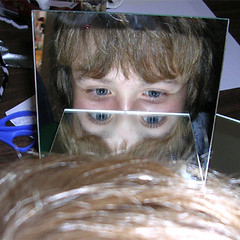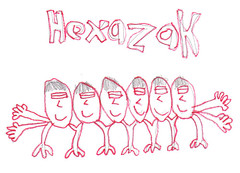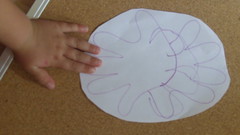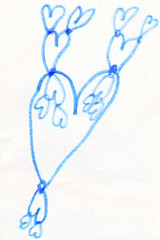This is the P2PU Archive. If you want the current site, go to www.p2pu.org!
Math-rich baby and toddler environment
My recent threads
You haven't posted any discussions yet.
Recently updated threads
- Put up some math-rich pictures! Mon, 2011-03-07 03:27
- End-of-course meeting Monday, and one last task... Mon, 2011-03-07 02:36
- Kirsten, Hailey and "hide-and-seek" game mechanic Tue, 2011-03-01 04:14
- Strewing math around the house: beyond numbers and shapes Wed, 2011-02-23 13:08
- Can your baby multiply? Sun, 2011-02-20 20:03
Put up some math-rich pictures!
I suggest creating multiple places around your home where you can easily and quickly put up pictures. And then adding lots of math pictures!
It is better to add something new to your picture places at least every day. This brings fresh attention to all the old pictures.
Where to get pictures? One of the best ways is to photograph the child doing something mathematical. For example, here are players of the Math Trek game making an inscribe polygon out of themselves:

http://www.flickr.com/groups/mathtrektriangle/
And here is a kid playing with the mirror book:

You can also draw pictures together with the kid. Include math ideas into the topics the child loves. For example, here is a picture of the prefix "hex-" (as in "hexagon") by a boy named Zak:

And here is a "star" made by a toddler and his mom by tracing hands, during a unit study on stars:

You can also print out cool math pictures that you and your kid find online. Here, for example, is a fractal cow my math club kids loved this week:

How can you put up pictures? First of all, they have to be at the eye level of the kid. For babies, measure the level of the eyes when you carry the baby, because you will be watching pictures together. Second, they have to be in busy places where you go a lot: corridors, kitchen, bathrooms... Here are a few methods:
- Whiteboard + scotch
- A fishing line or string along the wall, tied to two screws at the ends + clothespins
- Just wall + scotch (with smooth glossy paint, wood or stone)
- Cork board (not safe for babies because of pushpins)
Basically, you want to put up pictures in seconds. Then you can get into the habit of displaying any masterpiece the kid makes, or something you see in a journal, or a quick sketch of an idea.
~*~*~*~*~*
Here is a recipe for making "baby fractals" out of any shape your child likes. Try it at home!
- Draw an iconic number picture, for example, a dog with four paws.
- Dot the tips of your picture's "limbs." You will have the iconic number of dots, in this case, four.
- To make the second level of the picture, draw its smaller copy at each dot. Then dot those copies!
- Keep going for as many levels as you wish.
Here is a child's drawing of fractal heart from my math club last week:

This is also easy to make with tracing the big hand of the parent and smaller hand of the baby, or using finger paint to print. Here is a somewhat creepy computer-generated image of a fractal hand:

What math ideas will you show to your child?


I tried doing this with a series of triangles (easiest to draw for me) and at first Mark was pretty interested, but then moved onto something else pretty quick. I think if I had a picture book like this or maybe a giant poster, he'd be more interested.
Also, here's a fun math video that I shared with Maria and she suggested putting up on a forum - http://www.geekmom.com/2011/02/wind-and-mr-ug-get-non-euclidean
hi,
one way to make this more fun/interesting is to make the book. everyday or however your schedule is set up, you can work on different easy:) shapes and do a "build a book"
Hi Kenede, I see these books in stores sometimes and there are great books in our local library about different shapes and patterns too, but it'd be more fun to make one. Great idea!
Does Mark particularly love triangles?
I think this mostly works with beloved objects. You can ask him WHAT to draw, and then draw it - however simple and rough, it does not matter. Actually, very simple schematic drawings are better because kids can reproduce them: http://www.learningdesign.com/Portfolio/DrawDev/kiddrawing.html
But if you want pictures with triangles, search for Sierpinsky - there are also nice movies on YouTube. Here is one of my favorites from XKCD (a great math comic for adults - rated R):

http://math-art.net/wp-content/uploads/2009/02/sierpinski_valentine.png
Well, Mark' favorite shape is a circle, but I couldn't figure out the iconic number for a circle (seems like any number can work). I think this might be a good time to try that idea about drawing spirals that I told you about a while ago:
Where you have a grid of squares and you (or the child) calls out a number (let's say between 1 and 10). Then whoever is drawing will draw a line that's as many units long as the number. Then another number is called and another line is drawn at 90 degree angle to the first one, etc, etc. Oh, need to agree beforehand on the direction - clockwise or counterclockwise, I guess, and which way to start - up, down, left or right.
Check out the idea of a spirolateral - where you only call out 2-3 numbers and then keep repeating them. I noticed young kids had difficulties turning their spirals consistently. What we ended up doing was pairing up: one would turn the paper, always the same way, and the other draw.
I think you're right - that's exactly how it was set up. Actually, I now remember thinking up a sequence first and writing it down (i.e. 2,3,3,4,4,) and only then drawing the spiral.
Maria, I have hard time finding books with these kinds of pictures (and not having a printer, I can't print out the ones I find online). Sometimes I find beautiful pictures in National Geographics of various patterns formed by natural elements (bird's eye view of rice paddies would be one example). I thought about using those, but not sure if the message is the same.
Yelena, I used to spend a lot of time searching for pictures for my kid. Then it dawned on me that pictures that we MAKE together, as she watches and asks for details, are better. Even if their quality is very basic. The interaction is more important than the quality of the image. So, we usually spend a minute or two looking at shiny and high-quality pictures online, and then turn the computer off and make our own version! Does it make sense?
Maria, it does make sense and I'd love to do that. But I'm not sure it works with Mark. In general he has a very good attention span (for his age). For example, we can sit down and read a book for 30-40 minutes. But when it comes to anything like painting, drawing, cutting with scissors, etc his attention span is more like 1 minute, 2 tops (even if I do all the work). The time that I tried drawing triangles, he got bored after a minute or so and ran away. Did come back after a little while, but wasn't too interested in the process. Well, maybe I'll just draw the pictures beforehand.
I remember you saying that. Ask him what to draw and start telling a story. If he runs away, just finish yourself and put the picture up. The idea is that he will see the picture a few times (even for seconds at a time) and be reminded of math in it! So you can make a visual collection of different math ideas. If he sees something neat and finds math in it, even a simple idea, he can ask for it to be added to the display. You can also photograph "found math" to put up.
Thank you, Maria. I will try this tomorrow (Monday). I think I'll make up a story about Kolobok looking for friends :)